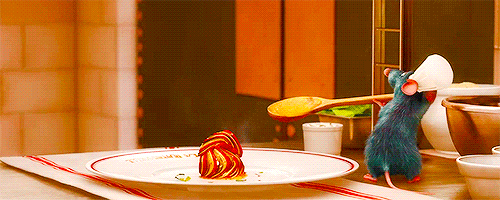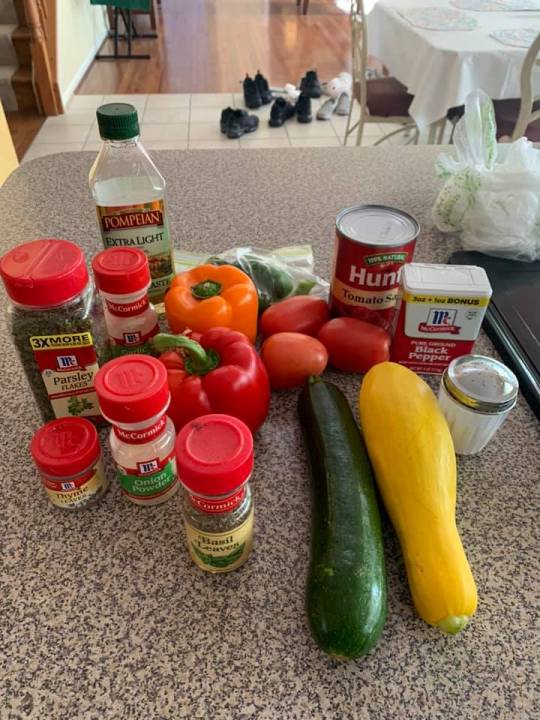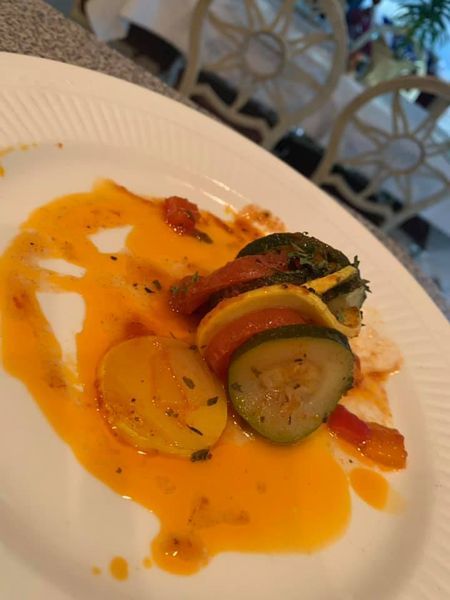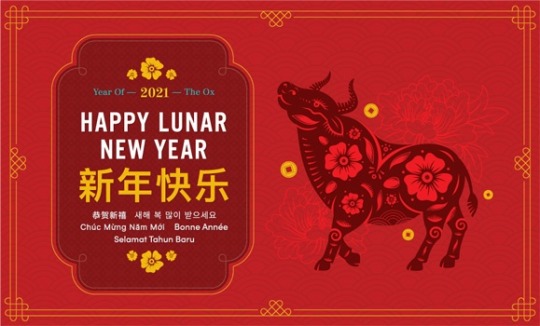Don't wanna be here? Send us removal request.
Text
Blog Post #4: Let's Talk About Ratatouille: the dish, not the movie.

Bonjour readers! Welcome to my 4th and final Blog Post.
Today I will be talking about French culture. Learning more about my roots and my family background, I found out that I am part French and I have a couple relatives living in Paris that my grandmother visits once every few years. I thought it would be exciting and fun to learn more about French culture while also learning the recipe for a famous dish called Ratatouille. Come along!

Origin:
Since the 17th century, France has been known to be a “center of high culture”. French culture has played a big role in shaping the world’s arts, cultures, sciences, and most of all being internationally recognized for its fashion, cuisine, art, and cinema. French culture was also historically shaped by Celtic, Roman, and Germanic cultures. As the largest Western European nation, France continues to be a powerhouse within the European continent. French ideas developed in the Enlightenment period, can all be seen as influencing present-day Western culture.
Connection to Class:

The French are known for their motto: "Liberté, Egalité, Fraternité”, which means Liberty, Equality, Fraternity. Connecting this to class, this motto can have different definitions with a few back translations. Back translation is defined as the process of translating a phrase back to its original language. An example of this would be if we back translate the French motto, in English, it means “Freedom, Equality, and Fraternity”. Another thing connecting the French to class is their religious life.
Most French citizens consider themselves to be Christian. Catholicism played an important role in shaping French culture and was the state religion until 1789. In the French tradition, kings were even crowned within the Notre-Dame de Reims cathedral until 1825. Most of the remaining population today identifies as agnostic or atheist. However, there are also significant groups of Muslim, Jewish, and Buddhist residents in modern France. The citizens in the French have a discrepancy in beliefs and have changed their belief from catholic to agnostic or atheist. As more people moved into France through time with the difference in religions and the lack thereof, religions like agnostic and atheist are becoming more predominant.
Yoga is gaining more popularity in France today. French citizens are not known for being passionate about exercise or fitness, but France has become a welcoming place for Yoga as a holistic practice, rather than a function of body manipulation or change. While Yoga is an ancient practice dating back thousands of years, French interest is more recent as they just adopted it in the 1960s, first based in India. As modern life expands and accelerates, Yoga is a touchstone for personal peace when everything else seems to speed up. Yoga in the French culture is typically done in groups at festivals and classes for people to come together as one.
The French immigrants coming to America is also a connection that can be made to this class. French chefs and restaurants bolstered the popularity of French cuisine and made the first yeast bread in North America while bringing technical farming skills all of which helped improve American rice and wines. America will always be different from French culture, but they were able to adapt and include the most beneficial parts of it including more effective farming. French culture does not just stay in one place, but rather it tries to spread its customs to other nations.
My Dish: Ratatouille

When we hear the word “Ratatouille”, many relate back to the Disney movie that came out in 2007, but it’s more than that. Ratatouille is a well-known vegetable stew from a region in France called Provence. It is a dish that contains eggplant, tomatoes, onions, bell peppers, zucchini, garlic, and herbs all cooked in olive oil and tomato sauce. It may not sound like much but it is considered a healthy and filling dish. The word “ratatouille” originated from Occitan ratatolha in the late 18th century in French, meaning to “stir up”. There are multiple methods of making this dish, which causes a debate as to what is the right way of cooking this meal. You can cook the vegetables together, or cooked separately then combined them at the end. You can even add protein to this dish if you want to. Ratatouille is a balanced meal suitable for vegetarians, vegans, and easy to make for anyone wanting to try it. Ratatouille is usually served as a side dish, but you can combine it with pasta, rice, or other protein so it can be served as a main dish. When I was making this dish, I added rice to it and it was very appetizing.


Overall Reflection:

This Ratatouille dish was my favorite dish out of my 4 dishes. Finding the ingredients was easy and it turned out just like I imagined it would taste in the film Ratatouille. Doing my research on French culture was interesting and being half French I am excited to tell extended family all about what I have learned and even fix this dish for my other family members in the future. Cooking dishes for this class has been an amazing experience and I can’t wait to find more recipes from different cultures to make in the future.
Thanks for reading! See you soon.
Sources:
https://thegoodlifefrance.com/yoga-in-france/
https://www.livescience.com/39149-french-culture.html
https://www.familysearch.org/blog/en/french-culture-traditions/
https://www.frenchcountryfood.com/recipes/vegetarian/ratatouille.html
https://americansall.org/legacy-partner/french-americans-contributions-our-nation#:~:text=French%20Americans%20mainly%20disseminated%20information%20and%20acted%20as,skills%20that%20vastly%20improved%20American%20rice%20and%20wines.
https://culturalatlas.sbs.com.au/french-culture/french-culture-core-concepts
https://www.thedailymeal.com/what-is-ratatouille
https://78.media.tumblr.com/9312bbd8c12df5b3cd572199ac78ce39/tumblr_omsq8nqDxF1qdqw3ro3_r1_500.gif
https://th.bing.com/th/id/R0b92cd77aed00a7e5d0a1483511b9e62?rik=F2xcqOjRptz7uw&riu=http%3a%2f%2fwww.badyogi.com%2fblog%2fwp-content%2fuploads%2f2018%2f11%2f34051846_911801859006058_4644739829039366144_o.jpg&ehk=D3SbIKeoWhGfUCkHLIHj30InP73wNB1jKusEjN0RUhc%3d&risl=&pid=ImgRaw
https://th.bing.com/th/id/R20ed9ad1b5dedcd848293191595b19fc?rik=yVGXA7e7shDJKA&riu=http%3a%2f%2f1.bp.blogspot.com%2f-pvtXgeafeIM%2fUQgNer8SWeI%2fAAAAAAAAjq8%2fUc8kd039seU%2fs1600%2feiffil-tower-eiffel-paris-france-park-cities-269184.jpg&ehk=JNzB3Rs1WjNHbZIGh4YwvyCK4mtgTK47gmTCzsvKCEA%3d&risl=&pid=ImgRaw
0 notes
Text
Blog Post #3: Japan's Buddhist Cuisine
Welcome back readers to Blog Post #3. In my previous blog, posts, I have shared dishes from the Chinese culture, Irish culture, and this post will be on the Japanese culture in connection to my new textbook Eastern Psychology: Buddhism, Hinduism, and Taoism. So come along!

Origin:
The Buddhist Cuisine Shojin Ryori is a traditional dining style of Buddhist monks in Japan, which grew popular in the 13th century with the rise of Zen Buddhism. The cuisine is made without meat, fish, or any animal, which makes this vegetable-based cuisine meal special. In many countries, this type of food is called “vegetarian”, but the Japanese native tongue the name “Shojin Ryori” meaning “devotion food” and is called as a form of respect to the tenets of Buddhism. Shojin Ryori was introduced to Japan by the monk Dogan, the founder of Zen Buddhism. Donk introduced this dining style as cuisine that balances body, spirit, and mind.

Connection with class:
In our new textbook Eastern Psychology: Buddhism, Hinduism, and Taoism author William Compton talk to readers about different practices. In Shojin Ryori cuisine, everything from colors, flavors, elements, and preparation methods are balanced and all exist in five variations. In most Buddhist traditions, the number five holds great significance. For Shojin Ryori, this means that you will likely be presented with five or more dishes with various tastes and textures to appeal to our five faculties. Shojin Ryori consists of the following 5 elements: earth (moderation, leveling), fire/summer (energy), metal/autumn(harvesting), wood/spring (growth, vitality), and water/winter (stillness, retreat). These elements can be connected with developments of positive psychology that focus on flourishing and the nature of a good life. The five primary colors: red, green, white, black, and yellow, are a part of the food pyramid of Japanese antiquity and believed to provide a healthy balance of nutrients. This balance in color and flavor is believed to provide nutritional balance while also bringing the body into balance with the seasons. In the textbook, we learn about practices, such as yoga, meditation, tai chi chuan, and martial arts. There seems to be a lack of understanding of practices like Yoga for people in America because we see Yoga as just meditating when in reality it’s more than that and has a deeper meaning. The purpose of Yoga in Buddhism is to aim for enlightenment. It is commonly known that many yoga practitioners are vegetarians for various reasons, and are committed to the vegan lifestyle. Traveling to other places, especially where your language is not spoken, can be difficult but Shojin Ryori is tourist-friendly and always recommended when visiting Japan.
My Dish: Shira-ao

Breaking down the two words “Shojin Ryori”, the prefixes and suffixes put the cuisine’s broader philosophy in context: Sho: to focus, Jin: to advance forward along the way, and Ryori: cooking/cuisine. Typical dishes in Shojin Ryori include preparing tofu, using soybeans or sesame seeds. The dish I chose to fix is called Shira-ae, a salad with mashed tofu and sesame-flavored vegetables. “Ae” is from the verb Aeru, which means dress vegetables. While “Shira” means white for the tofu. This is a dish, often described as a dressing, that can be expected to be found at any Shojin Ryori Restaurant.

Reflection:

Learning about the Buddhist Cuisine Shojin Ryori origin and cooking one of their well-known dishes, Shira-ao was a great experience. The ingredients were easy to find and preparing the meal was easy as well. With the help of my twin sister, cooking this dish was a success in my household. Since my sister and I do not attend the same colleges, it can be hard to find time to spend time together. Cooking the Shira-ao dish gave us the chance to spend time together and I got the chance to teach her about the things I’ve been learning in this course. Want to see what I decide to cook next time? Stayed tuned to see.
Thanks for reading Cooking with Jess.
https://allabout-japan.com/en/article/6513/
https://savorjapan.com/contents/more-to-savor/shojin-ryori-japans-sophisticated-buddhist-cuisine/#:~:text=Typical%20Shojin%20Ryori%20Dishes%20A%20shojin%20ryori%20meal,made%20with%20root%20vegetables%2C%20vegan%20dashi%2C%20and%20tofu.
https://recipesjourney.com/en/shojin-ryori-the-buddhist-diet/
https://medium.com/@chietakemoto11/traditional-japanese-buddhist-cuisine-shojin-ryori-starter-guide-2cc48d728913
https://www.gojourny.com/stories/shojin-ryori-japanese-buddhist-cuisine/
https://cooklabo.blogspot.com/2016/08/blog-post.html
Pictures Sources:
https://th.bing.com/th/id/Rc94a9d7ccd5c14db75b681a84177b9e6?rik=Te4SKbAe6d4%2fmA&riu=http%3a%2f%2fwww.existentialbuddhist.com%2fwp-content%2fuploads%2f2015%2f04%2fEihei-Dogen.jpg&ehk=vDvh0n4PNu334oLZgcG%2fUrTOsVEQBVkiLQ97pXybFEA%3d&risl=&pid=ImgRaw
https://media.giphy.com/media/1485Lvt6DmN6gg/giphy.gif
1 note
·
View note
Text
Come Celebrate St. Patrick's Day with this dish
Hello readers! Welcome back to my blog! This week, in celebration of St. Patrick’s Day approaching, I decided to cook an Irish dish and talk about the origin behind it.
Origin of St. Patrick Day

St. Patrick Day celebrated annually on March 17th, is known as the feast day of the patron saint of Ireland, Saint Patrick. The reason for the date of March 17th is because it’s the anniversary of his death in the 5th century. In Ireland, St. Patrick’s Day has been a national holiday since the beginning of the 20th century. It was not until the 1930s when the first parade was held in his honor. Even though the holiday is named after a saint, people mostly associate it with celebrating Irish culture, rather than Catholicism. Today the St.Patrick celebration includes traditional Celtic music, dancing, and dresses, but these things are absent in Ireland’s own celebration. In modern-day Ireland, St. Patrick’s Day, the Irish government uses the interest in St. Patrick’s Day to drive tourism and showcase Ireland and Irish culture to the rest of the world.
Origin of Saint Patrick

Saint Patrick, known as the Patron Saint of Ireland and the Apostle of Ireland, was a bishop and missionary in Ireland in the late 5th century AD. Relating to chapter 6 in our class textbook, though Saint Patrick is connected to Irish, he was not Irish by birth. He may have not been Irish by birth but he still embodied the spirit of Ireland in him. Connecting him with ingroup and outgroup, he would be in the ingroup since this identity of being Irish gives him a sense of belonging.
Even though Saint Patrick is the “patron saint of Ireland”, he immigrated to Ireland, just like so many Irish people would later become immigrants in the United States. In Chapter 7 of the textbook, we talked about faith culture which perfectly ties in with Saint Patrick in a few ways. Saint Patrick is the reason why Shamrocks are associated with his feast day. It is said that Saint Patrick once used shamrocks to explain the Holy Trinity, three persons in one God. Since then, it is traditional for Irishmen to wear them on St.Patrick’s Day.
My Dish: Colcannon.

The dish I made in celebration of Saint Patrick’s Day was called Colcannon, a term from the Gaelic term “cal ceannann”. During the 1600 and 1700s in Europe and Ireland, potatoes, cabbages, and leeks were very common food, so this dish is a combination of all of them. Colcannon is a true Irish soul food dish. The Irish tradition is to serve colcannon as the main dish for festivities and refer to it as “Colcannon Night”. Cultural differences have been spoken about in this class, and just as Americans have a single lady catch the wedding bouquet foretelling who will get married next, Colcannon is used for foretelling marriages too. Charms such as rings, coins, and thimbles, are wrapped and hidden in bowls of colcannon during the event. The lucky young single lady to find the ring in her bowl could find a marriage proposal soon waiting for her and she would likely marry within the year before the next Colcannon night. Irish immigrants that came to the United States, introduced colcannon to American cuisine and you will find it served in America more commonly on Saint Patrick’s Day.


Overall Reflection
This Colcannon dish was amazing and turned out a success. Children are taught growing up seeing St. Patrick’s Day as a day to collect coin, leprechauns, and pinching people that aren't wearing the color green, and it’s much more than that. Doing my research and connecting this holiday with what we have been learning in this cross-cultural class helps me appreciate the holiday more than before. Cooking the Colcannon dish even gave me the chance to spend time with my dad in the kitchen which was new and fun. I got to not only teach him but teach myself. These dishes have been fun so far and I can.t wait to see what I do next so stay tuned.
Thank you for reading and see you soon!
Sources:
“The History Of Saint Patrick's Day - the True Origins of the Holiday.” 123Dentist, 6 May 2019, www.123dentist.com/the-history-of-saint-patricks-day/.
History.com Editors. “History of St. Patrick's Day.” History.com, A&E Television Networks, 27 Oct. 2009, www.history.com/topics/st-patricks-day/history-of-st-patricks-day.
Saint Patrick's Day. 9 Mar. 2021, www.britannica.com/topic/Saint-Patricks-Day.
“St. Patrick.” Encyclopædia Britannica, Encyclopædia Britannica, Inc., www.britannica.com/biography/Saint-Patrick.
Stradley, Linda. “Irish Colcannon Potato Recipe.” What's Cooking America, 13 June 2019, whatscookingamerica.net/Vegetables/Irish-Colcannon-Potatoes.htm.
Picture Sources:
Https://Th.bing.com/Th/Id/Rcd153f5af794dae38edc3808b3acfab0?Rik=8gje4L%2bzDOfyWg&Riu=Http%3a%2f%2fwww.Irelands-Hidden-Gems.com%2fimages%2fstpatrickimage.Jpg.pagespeed.ce.zRU_WveU2u.Jpg&Ehk=vX5HP%2fQafK7cJ65RraaFkZaawI%2bZ2BXqMYDM1rmaV7k%3d&Risl=&Pid=ImgRaw.
Https://Www.partyrama.co.uk/Wp-Content/Plugins/Partyrama-Ecommerce-pro/Includes/pro-Images/Prod-Img/Default/Happy-St-Patricks-Day-Design-Personalised-Banner-Product-Image.jpg.
0 notes
Text
Happy Lunar New Year
For my first blog post, I will be talking about the Chinese Lunar New Year.

The Lunar New Year, also known as Spring Festival is a festival often celebrated in China and other Asian countries, in celebration of the first new moon of the lunar calendar. Even though it is hard to figure out what exact date the festivals started, the Chinese new year started in 14th century BCE. Every year the date of the beginning of the Lunar New Year changes, this year it was celebrated on Friday, February 12. The festival lasts 15 days and ends on the lunar calendar’s first full moon. Every Lunar New Year comes with traditional family celebrations, dances, and fireworks. At the end of the new year celebrations comes the Lantern Festival. During this last night, lanterns are used to light up the night sky. Traditional foods like fish, sticky rice balls, and noodles are served at dinner so families can come together and celebrate.
Origin of the Zodiac Animals

Every Lunar New Year is connected to a Zodiac animal. Each animal represents unique attributes and themes for that year. This year is the year of the Ox, the theme of hard work and progress. For centuries, the Ox has been used for man to build and grow a better life. Every year the zodiac animal changes and has a whole different meaning. In the Chinese culture, a person’s Chinese zodiac sign is matched to the year they were born, for example, I was born in the year 2001 meaning my zodiac animal is a snake. Even if this year’s animal is not my sign, I can still view this year of the Ox is a time to reflect and learn until my year comes. In the American culture, we use zodiac animals in connection to our birthday days instead of birth years. That’s the cool thing about cultures, we may have differences but we have similarities as well.

Origin of my Dish
In honor of the new year, I decided to learn and cook Chinese Lo Mein noodles. The Chinese believe that every meal needs equal amounts of grains and Tsai (fruits and vegetables). Noodles are an excellent dish for this perfect balance. Even though noodles are used in Chinese dishes year-round, during the Lunar New Year and other celebrations, having noodles is a dinner must-have because of its symbolic meaning. In Chinese culture, noodles are a symbol of longevity and having a longer life. In my cross-cultural course, I have learned more about the importance of cultural differences and the traditions that make them different. Making this dish, I learned that in the Chinese culture, they do not cut noodles because in their culture noodles are meant to be slurped when eating. During this experience when eating with my family, I made sure to tell them this information, so when eating the dish I made sure we ate following this cultural practice.

Overall Reflection
Making the dish of the Lo Mein noodles was a success and I enjoyed learning the origin behind the dish and connecting it to information found in my class. I have had Lo Mein noodles before, but getting all the ingredients and fixing this dish myself brought me a closer experience and deeper insight into the Chinese culture that I do not usually get. I am excited to see what cultural dish I describe to make next! Stay tuned for more.
Sources
Ainsworth, Colin. “5 Fast Facts about the Lunar New Year.” Mental Floss, 4 Feb. 2019, www.mentalfloss.com/article/573107/lunar-new-year-facts#:~:text=5%20Fast%20Facts%20about%20the%20Lunar%20New%20Year,to%2014th%20century%20BCE.%20...%20More%20items...%20.
Avia. “Chinese Zodiac Animal Signs and Chinese New Year Meaning.” Whats, 10 Nov. 2020, www.whats-your-sign.com/chinese-zodiac-animal-and-chinese-new-year.html.
“Lunar New Year.” Encyclopædia Britannica, Encyclopædia Britannica, Inc., www.britannica.com/topic/Lunar-New-Year.
https://www.recipetineats.com/lo-mein-noodles/
1 note
·
View note